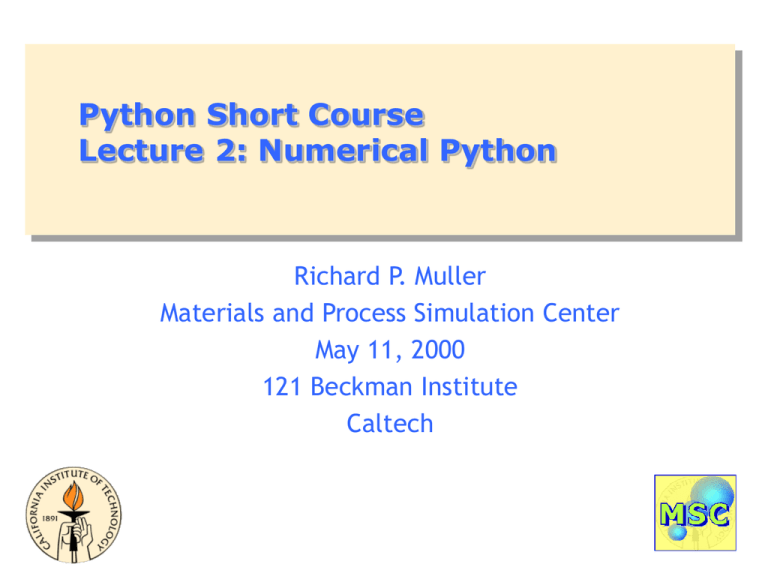Python Short Course Lecture 2: Numerical Python Richard P. Muller
advertisement

Python Short Course Lecture 2: Numerical Python Richard P. Muller Materials and Process Simulation Center May 11, 2000 121 Beckman Institute Caltech NumPy Modules • NumPy has many of the features of Matlab, in a free, multiplatform program. It also allows you to do intensive computing operations in a simple way • Numeric Module: Array Constructors – ones, zeros, identity – arrayrange • LinearAlgebra Module: Solvers – – – – – Singular Value Decomposition Eigenvalue, Eigenvector Inverse Determinant Linear System Solver © 2000 Richard P. Muller 2 Simple Numeric Constructors • Arrays are slightly different from lists. They can only contain one type of data structure, and they are much faster to work with numerically. >>> from Numeric import * >>> s = arrayrange(0,2*pi,0.1) #"arange" also >>> print s [0., 0.1, ... 6.2] >>> sin(s) #Numeric.sin maps onto arrays [0., 0.099833, ... -0.0830894] © 2000 Richard P. Muller 3 Shape and reshape >>> a = zeros((3,3),Float) >>> print a [[0.,0.,0.], [0.,0.,0.], [0.,0.,0.]] >>> print a.shape (3,3) >>> reshape(a,(9,)) # could also use a.flat >>> print a [0.,0.,0.,0.,0.,0.,0.,0.,0.] © 2000 Richard P. Muller 4 Arrays and Constructors >>> a = ones((3,3),Float) >>> print a [[1., 1., 1.], [1., 1., 1.], [1., 1., 1.]] >>> b = zeros((3,3),Float) >>> b = b + 2.*identity(3) #"+" is overloaded >>> c = a + b >>> print c [[3., 1., 1.], [1., 3., 1.], [1., 1., 3.]] © 2000 Richard P. Muller 5 Overloaded operators >>> b = 2.*ones((2,2),Float) #overloaded >>> print b [[2.,2.], [2.,2.]] >>> b = b+1 # Addition of a scalar is >>> print b # element-by-element [[3.,3.], [3.,3.]] >>> c = 2.*b # Multiplication by a scalar is >>> print c # element-by-element [[6.,6.], [6.,6.]] © 2000 Richard P. Muller 6 More on overloaded operators >>> c = 6.*ones((2,2),Float) >>> a = identity(2) >>> print a*c [[6.,0.], # ARGH! element-by-element! [0.,6.]] >>> matrixmultiply(a,c) [[6.,6.], [6.,6.]] © 2000 Richard P. Muller 7 Array functions >>> from LinearAlgebra import * >>> a = zeros((3,3),Float) + 2.*identity(3) >>> print inverse(a) [[0.5, 0., 0.], [0., 0.5, 0.], [0., 0., 0.5]] >>> print determinant(inverse(a)) 0.125 >>> print diagonal(a) [0.5,0.5,0.5] >>> print diagonal(a,1) [0.,0.] – transpose(a), argsort(), dot() © 2000 Richard P. Muller 8 Eigenvalues >>> from LinearAlgebra import * >>> val = eigenvalues(c) >>> val, vec = eigenvectors(c) >>> print val [1., 4., 1.] >>> print vec [[0.816, -0.408, -0.408], [0.575, 0.577, 0.577], [-0.324, -0.487, 0.811]] – also solve_linear_equations, singular_value_decomposition, etc. © 2000 Richard P. Muller 9 Least Squares Fitting • Part of Hinsen's Scientific Python module >>> from LeastSquares import * >>> def func(params,x): # y=ax^2+bx+c return params[0]*x*x + params[1]*x + params[2] >>> data = [] >>> for i in range(10): data.append((i,i*i)) >>> guess = (3,2,1) >>> fit_params, fit_error = leastSquaresFit(func,guess,data) >>> print fit_params [1.00,0.000,0.00] © 2000 Richard P. Muller 10 FFT >>> from FFT import * >>> data = array((1,0,1,0,1,0,1,0)) >>> print fft(data).real [4., 0., 0., 0., 4., 0., 0., 0.]] • Also note that the FFTW package ("fastest Fourier transform in the West") has a python wrapper. See notes at the end © 2000 Richard P. Muller 11 Example: Particle in a Box N = 100 T = get_kinetic_energy(N) V = get_particle_box_potential(N) H = T + V val, vec = eigenvectors(H) val, vec = ev_sort(val, vec) plot_results(vec[:2]) © 2000 Richard P. Muller 12 Finite Difference Approximation • Consider a set of functional values on a grid x fi+1 x f0 x fi-1 x fi • We can calculate forward and backwards derivatives by simple differences – df- = (fi - fi-1)/h – df+ = (fi+1 - fi)/h • We can take differences of these to get an approximation to the second derivative – ddf = (df+ - df-)/h – ddf = (fi-1 - 2fi + fi+1)/h2 © 2000 Richard P. Muller 13 get_kinetic_energy function def get_kinetic_energy(N): T = zeros((N,N),Float) + identity(N) for i in range(N-1): T[i,i+1] = T[i+1,i] = -0.5 return T 1.0 -0.5 -0.5 1.0 -0.5 -0.5 1.0 -0.5 -0.5 1.0 © 2000 Richard P. Muller 14 get_particle_box_potential function def get_particle_box_potential(N): border = 5 V = zeros((N,N),Float) for i in range(border): V[i,i] = V[N-1-i,N-1-i] = 100. return V V=100 V=0 5 N-10 5 © 2000 Richard P. Muller 15 Particle in a Box Wave Function © 2000 Richard P. Muller 16 Example: Harmonic Oscillator N = 100 T = get_kinetic_energy(N) V = get_harmonic_oscillator_potential(N) H = T + V val, vec = eigenvectors(H) val, vec = ev_sort(val, vec) plot_results(vec[:2]) © 2000 Richard P. Muller 17 get_harmonic_oscillator_potential def get_harmonic_oscillator_potential(N): midpoint = N/2 + 0.5 K = 0.5/(N*N) # independent of N V = zeros((N,N),Float) for i in range(N): delx = i - midpoint V[i,i] = 0.5*K*delx*delx return V V=1/2 K(x-xo)2 N/2 © 2000 Richard P. Muller 18 Harmonic Oscillator Wave Function © 2000 Richard P. Muller 19 Example: One-D Hydrogen N = 100 T = get_kinetic_energy(N) V = get_oned_hydrogen_potential(N) H = T + V val, vec = eigenvectors(H) val, vec = ev_sort(val, vec) plot_results(vec[:2]) © 2000 Richard P. Muller 20 get_oned_hydrogen_potential def get_oned_hydrogen_potential(N): midpoint = N/2 + 0.5 Qeff = 3./N # independent of N V = zeros((N,N),Float) for i in range(N): delx = i - midpoint V[i,i] = -Qeff/abs(delx) return V V=-Q/abs(x-xo) N/2 © 2000 Richard P. Muller 21 One-D Hydrogen Eigenvectors © 2000 Richard P. Muller 22 Command Line Arguments • We would like to be able to choose the different potentials via command-line flags, i.e., % one_d_hamiltonian.py -b -n 50 (Box wave function with 50 points) % one_d_hamiltonian.py -s (Spring wave function with 100 points) % one_d_hamiltonian.py -h -n 200 (One-D H wave function with 200 points) © 2000 Richard P. Muller 23 getopt module opts, args = getopt.getopt(sys.argv[1:],'bshn:') for opt in opts: key,value = opt if key == '-b': potential == 'box' elif key == '-s': potential == 'spring' elif key == '-h': potential == 'hydrogen' elif key == '-n': N = eval(value) © 2000 Richard P. Muller 24 Example: Tight Binding Band Structure of Semiconductors © 2000 Richard P. Muller 25 Tight Binding Theory • Extended-Huckel treatment of electronic structure – Diagonal elements of H have a self term. – Off-diagonal elements of H have a term related to the coupling • Include periodic boundary conditions • k-points sample different space group symmetries • Look at a sample Hamiltonian – – – – Diamond, cubic Zincblend structures 2 atoms per unit cell (cation and anion) Minimal basis (s,px,py,pz) functions on each atom Off-diagonal coupling is modulated by phase factors © 2000 Richard P. Muller 26 Harrison Hamiltonian sc sa sc Esc Essg0 sa Essg0 Esa pxc -Espg1 pyc -Espg2 pzc -Espg3 pxc pyc pzc pxa pya pza Espg1 Espg2 Espg3 Exxg0 Exyg3 Exyg2 Exyg3 Exxg0 Exyg1 Epa Exyg2 Exyg1 Exxg0 Epa -Espg1* -Espg2* -Espg3* Epc Epc pxa Espg1* Exxg0 * Exyg3 * Exyg2 * pya Espg2* Exyg3 * Exxg0 * Exyg1 * pza Espg3* Exyg2 * Exyg1 * Exxg0 * Epa Epa © 2000 Richard P. Muller 27 Harrison Parameters • C and A refer to cation and anion – Ga,N for a 3,5 semiconductor in Cubic Zincblende form – Si,Si for a pure semiconductor in Diamond form • Es, Esp, Exx, Exy are fit to experiment • g0, g1, g2, g3 are functions of the k-vectors – – – – k-vectors are phase factors in reciprocal space show how band various in different space group symmetries g0(k) = e-ikd1 + e-ikd2 + e-ikd3 + e-ikd4 Tetrahedral directions: d1 = [111]a/4, d2 = [1-1-1]a/4 © 2000 Richard P. Muller 28 Outline of TB Program kpoints = get_k_points(N) energy_archive = [] for kpoint in kpoints: H = get_TB_Hamiltonian(kpoint) energies = eigenvalues(H) energies = ev_sort(energies) energy_archive.append(energies) gnuplot_output(energy_archive) © 2000 Richard P. Muller 29 get_k_points function def get_k_points(N): kpoints = [] kx,ky,kz = 0.5,0.5,0.5 #L Point k_points.append((kx,ky,kz)) step = 0.5/float(N) for i in range(N): # Move to Gamma (0,0,0) kx,ky,kz = kx-step,ky-step,kz-step k_points.append((kx,ky,kz)) # Similar steps for X (1,0,0) & K (1,1,0) return kpoints © 2000 Richard P. Muller 30 get_TB_Hamiltonian function def get_TB_Hamiltonian(kpoint): phase_factors = get_phases(kpoint) H = zeros((8,8),Complex) H = set_diag_values(H) H = set_off_diag_values(H,phase_factors) return H © 2000 Richard P. Muller 31 Band Structure Output © 2000 Richard P. Muller 32 Numeric Python References – http://numpy.sourceforge.net NumPy Web Site – http://numpy.sourceforge.net/numpy.pdf NumPy Documentation – http://starship.python.net/crew/hinsen/scientific.html Konrad Hinsen's Scientific Python page, a set of Python modules useful for scientists, including the LeastSquares package. – http://starship.python.net/crew/hinsen/MMTK/ Konrad Hinsen's Molecular Modeling Tool Kit, a biological molecular modeling kit written using Numerical Python. – http://oliphant.netpedia.net/ Travis Oliphant's Python Pages, including: FFTW, Sparse Matrices, Special Functions, Signal Processing, Gaussian Quadrature, Binary File I/O © 2000 Richard P. Muller 33 Tight Binding References W. A. Harrison. Electronic Structure and the Properties of Solids. Dover (New York, 1989). D. J. Chadi and M. L. Cohen. "Tight Binding Calculations of the Valence Bands of Diamond and Zincblende Crystals." Phys. Stat. Solids. B68, 405 (1975). http://www.wag.caltech.edu/home/rpm/projects/tight-binding/ My tightbinding programs. Includes one that reproduces Harrison's method, and one that reproduces Chadi and Cohen's methods (the parameterization differs slightly). http://www.wag.caltech.edu/home/rpm/python_course/tb.py Simplified (and organized) TB program. © 2000 Richard P. Muller 34





